《语言学入门》期末复习题(2013秋) .doc
语言学期末考试试题

语言学期末考试试题一、选择题(每题 2 分,共 30 分)1、语言的本质属性是()A 社会性B 生理性C 物理性D 心理性2、下列属于音素的是()A aiB pC auD ei3、汉语普通话中“妈”“麻”“马”“骂”的声调不同,主要是由于()A 音高B 音强C 音长D 音色4、最小的有意义的语言单位是()A 语素B 词C 短语D 句子5、“巧克力”是()A 单纯词B 合成词C 派生词D 复合词6、下列词中属于偏正结构的是()A 提高B 黑板C 心疼D 地震7、“他跑得很快”中“得”的作用是()A 表示可能B 表示程度C 表示结果D 表示趋向8、下列句子属于兼语句的是()A 他叫我去买东西。
B 我知道他来。
C 他有个妹妹很可爱。
D 大家选他当班长。
9、下列属于外来词的是()A 电脑B 沙发C 电话D 电视10、语言发展的基本条件是()A 社会的发展B 语言内部的矛盾C 不同语言的接触D 个人的创造11、现代汉民族共同语是以()为标准音。
A 北京语音B 北方语音C 南京语音D 广州语音12、下列方言中属于吴方言的是()A 上海话B 厦门话C 南昌话D 长沙话13、语言融合的方式通常是()A 自愿融合B 被迫融合C 自然融合D 人工融合14、下列语言中属于屈折语的是()A 汉语B 英语C 日语D 朝鲜语15、语言符号的任意性是指()A 语言符号的形式和意义之间没有必然联系B 语言符号的形式和意义之间存在必然联系C 语言符号可以随意改变形式和意义D 语言符号的形式和意义是固定不变的二、填空题(每题 2 分,共 20 分)1、语言是人类最重要的________工具和________工具。
2、语音四要素包括音高、音强、音长和________。
3、元音和辅音最主要的区别是________。
4、词的组合的五种基本类型是主谓结构、动宾结构、偏正结构、中补结构和________。
5、句子按语气可以分为陈述句、疑问句、祈使句和________。
语言学期末考试题及答案

语言学期末考试题及答案一、选择题(每题2分,共20分)1. 语言学是研究语言的科学,其主要研究对象是语言的()。
A. 历史演变B. 社会功能C. 结构系统D. 所有选项答案:D2. 以下哪项不是语言学的分支学科?A. 语音学B. 语义学C. 心理学D. 句法学答案:C3. 语言的最小意义单位是()。
A. 音素B. 词C. 词素D. 语素答案:A4. 语言学家索绪尔认为语言符号是由哪两个部分组成的?A. 语义和语法B. 语音和语义C. 能指和所指D. 形式和内容5. 以下哪个选项是语言的交际功能?A. 信息传递B. 表达情感C. 思考工具D. 所有选项答案:D6. 语言的音位系统是由()决定的。
A. 社会约定B. 个人习惯C. 物理属性D. 语法规则答案:A7. 以下哪个不是语言的变异现象?A. 方言B. 社会方言C. 语言混合D. 语言的稳定性答案:D8. 语言的词汇系统包括()。
A. 词根B. 词缀C. 词D. 所有选项答案:D9. 语言的语法系统包括()。
B. 词法C. 音位学D. 所有选项答案:D10. 以下哪项是语言的内部因素?A. 社会因素B. 心理因素C. 语言接触D. 语言的规则性答案:D二、填空题(每题2分,共20分)1. 语言学研究的对象是______,研究的方法是______。
答案:语言;科学的方法2. 语言的音位系统是由______决定的,而词义系统是由______决定的。
答案:社会约定;社会约定3. 语言的最小意义单位是______,而最小的语音单位是______。
答案:语素;音素4. 索绪尔将语言符号分为两个部分:______和______。
答案:能指;所指5. 语言的交际功能包括信息传递、表达情感和______。
答案:思考工具6. 语言的变异现象包括方言、社会方言和______。
答案:语言混合7. 语言的词汇系统包括______和______。
答案:词根;词缀8. 语言的语法系统包括______和______。
《语言学概论》 期末检测试题3套含答案(大学期末复习资料).doc
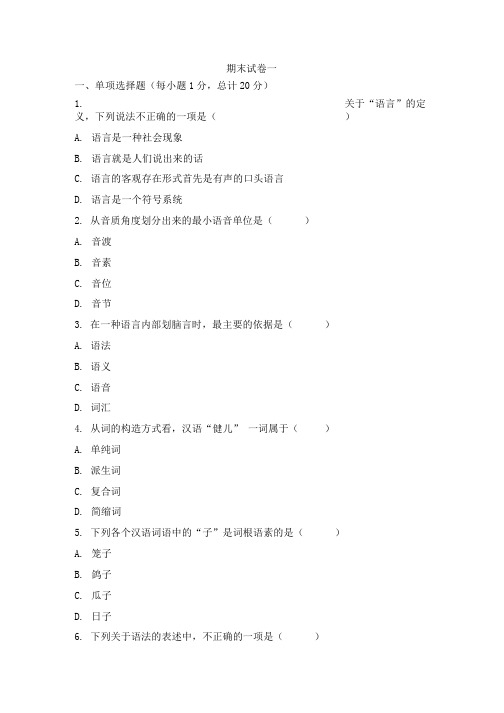
期末试卷一一、单项选择题(每小题1分,总计20分)1.关于“语言”的定义,下列说法不正确的一项是()A.语言是一种社会现象B.语言就是人们说出来的话C.语言的客观存在形式首先是有声的口头语言D.语言是一个符号系统2.从音质角度划分出来的最小语音单位是()A.音渡B.音素C.音位D.音节3.在一种语言内部划脑言时,最主要的依据是()A.语法B.语义C.语音D.词汇4.从词的构造方式看,汉语“健儿” 一词属于()A.单纯词B.派生词C.复合词D.简缩词5.下列各个汉语词语中的“子”是词根语素的是()A.笼子B.鸽子C.瓜子D.日子6.下列关于语法的表述中,不正确的一项是()A.语法是关于词的构成变化和词构成词组和句子的规则B.语法是说本族语的人的直觉知识和约定习惯C.语法是与语音、语汇等要素互不相关的规则D.语法是与语音、语汇等相比变化较慢的现象7.下列关于词义模糊性的表述中,正确的一项是()A.词义所指范围边缘区域模糊,中心区域明确B.词义所指范围边缘区域明确,中心区域模糊C.词义所指范围边缘区域、中心区域都模糊D.词义所指范围边缘区域可能模糊8.“哈巴狗”和“狮子狗”指的是同一种狗,二者在词义上的主要差别是()A.理性意义不同B.语体色彩不同C.形象色彩不同D.语气意义不同9.下列各项中,含有降级述谓结构的是()A.他申请去北京进修B.你去请他比较好C.他取下了挂在墙上的地图D.他害怕老师批评他10.下列各项中,甲和乙之间是预设关系的是()A.(甲)他有一件西服(乙)他有一件衣服B.(甲)他的西服破了(乙)他有一件西服C.(甲)那个学生借给他一本《红楼梦》一一(乙)那个人借给他一本《红楼梦》D.(甲)那个学生借给他一本《红楼梦》一一(乙)那个学生借给他一本书11.1956年我国推行汉字简化方案,将繁体字改成简体字,这属于()A.正字法改革B.字符类型改革C.文字类型改革D.字符类型和文字类型改革12.汉语中的“基因”来自英语的gene,从该词产生的方式看,“基因”属于(A.纯粹音译词B.音译兼意译词C.意译词D.仿译词13.从语言的发展演变来看,语汇系统中最不易发生变化的是()A.通用语汇B.常用语汇C.基本语汇D.专用语汇14.关于社会方言的形成,下列说法不正确的一项是()A.社会方言大多是在语言的相互接触中形成的B.社会方言是随着社会的社群分化而产生的C.一种语言的内部有可能形成社会方言D.一种方言的内部有可能形成社会方言15.关于共同语的形成,下列说法不正确的一项是()A.并不意味着方言分歧已经消失B.并不意味着方言分歧将会扩大C.并不意味着方言最终将被取代D.并不意味着语言已经实现统一16.关于语言规范化的推行,下列说法不正确的一项是()A.主要由权威机构提出具体的规范意见B.主要由权威机构强制推行C.主要通过教育机构、大众传媒等渠道向社会推行D.主要是一个积极引导社会公众自觉遵守的过程17.关于语言获得的原因,下列学说中偏重于内部条件解释的是()A.模仿说B.天赋说C.强化说D.刺激反应说18.社会语言学属于()A.理论语言学B.广义应用语言学C.普通语言学D.狭义应用语言学19.汉语中的:“了、着、过”在古代具有实实在在的词汇意义,到现代变成只表语义的助词,这属于()A.异化B.类化C.新语法范畴的形成D.实词虚化20.下列语言中属于粘着语的是()A.苗语B.越南语C.俄语D.日语二、多项选择(每个小题3分,共30分)1.根据舌位的高低,元音可分为()A.高兀音B.央元音C.半高元音D.半低元音E.低元音2.下列汉字的读音中多包含有辅音[飞]的有()A.男B.拉C.拿D.拦E.驴3.下列词中带有前缀的是(%1老鼠%1画家%1阿姨%1超越%1超现实主义4.下列词组叫,带双宾语的是()%1托你一件事%1托你办件事%1请你办这件事%1借你五元钱%1给你一本书5.下列语素中,属于枯着语素的是()%1宏%1伟%1大%1楼%1机6.卞列语言单位中,属于派生词的是()%1律师%1鸟儿%1老婆%1苦头%1文学家7.下列词中,处于同一个语义场的词是()%1桌子%1椅子%1沙发%1柜子%1鞋子8.下列语言属于印欧语系的是()%1法语%1英语%1德语%1阿拉伯语%1维吾尔语9.汉语属于()%1汉藏语系%1汉语族%1屈折语%1孤立语%1粘着语10.下列文字中属于表意文字的是()%1汉字%1中美洲的马雅文字%1古埃及的圣书字%1我国纳西族的东巴文%1古印度的法卢文三、判断题(每题2分,共20分)1.符号有视觉符号、听觉和触觉符号三种,语言是一种视觉符号。
语言学概论》期末考试复习题及参考答案

语言学概论》期末考试复习题及参考答案语言学概论复题一、单项选择题1.音高取决于什么?A.发音体振动的振幅B.发音体振动的频率C.发音体振动的持续时间D.共鸣器的形状2.北京话“慢”单念时读[man],但“慢慢儿”却有人读做[maimar],前一音节的语流音变现象是什么?A.同化B.异化C.弱儿D.增音3.英语“worker”中的“-er”是什么?A.构词语素B.构形语素C.虚词语素D.词根语素4.下列汉语词语中的“儿”不属于词根语素(实义语素)的是什么?A.健儿B.女儿C.少儿D.花儿5.“吓唬”和“恐吓”在非理性意义上的主要差别是什么?A.语气意义不同B.感情色彩不同C.语体色彩不同D.形象色彩不同6.“XXX说服了XXX”中“XXX”是行为的施事,“XXX”是行为的受事,这种意义是什么?A.语汇意义B.语法意义C.语境意义D.蕴含意义7.语言成分的借用,最常见、最突出的是什么?A.词语的借用B.语音成分的借用C.词缀的借用D.语法结构的借用8.下列几种类型的社会方言中,具有排他性的是什么?A.行话B.黑话C.官腔D.贵族语言9.下列辅音音素都是XXX的一组是什么?A.[d。
l]B.[b。
k]C.[p。
n]D.[t。
v]10.从语音的社会功能角度划分出来的最小语音单位是什么?A.音位B.音素C.音节D.音渡11.英语“students”中的“-s”是什么?A.虚词语素B.词根语素C.构形语素D.构词语素12.下列现象中不属于词法手段的是什么?A.虚词B.重叠C.轻重音D.词形变化13.下面词组中,结构类型与其他各组不同的一组是什么?A.年轻漂亮/朴素大方B.我们大家/首都北京C.铁路民航/工人农民D.贯彻执行/讨论研究14.下列成对的词语中,属于相对反义词的一组是什么?A.成功—失败B.合法—非法C.本地—外地D.勤劳—懒惰15.造成“北京人多”一句歧义的主要原因是什么?A.一词多义B.不同的句法结构关系C.不同的语义结构关系D.不同的层次构造16.下列关于语言起源的表述中,正确的一项是什么?A.语言产生于人类对外界各种声音的摹仿B.语言产生于人们的相互约定C.语言是人类有意识地在短时间内创造出来的D.语言是人类在长期进化发展过程中创造出来的17.在儿童学会说话的过程中,“双词阶段”标志着儿童已经具备了语法能力,能够组合两个词来表达意思。
语言学期末考试题及答案
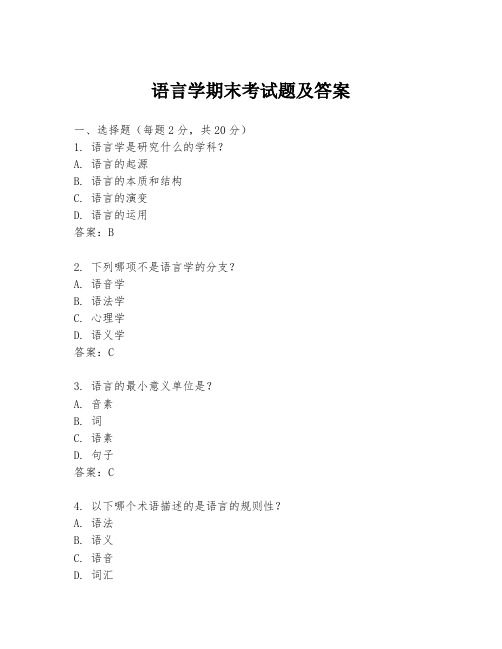
语言学期末考试题及答案一、选择题(每题2分,共20分)1. 语言学是研究什么的学科?A. 语言的起源B. 语言的本质和结构C. 语言的演变D. 语言的运用答案:B2. 下列哪项不是语言学的分支?A. 语音学B. 语法学C. 心理学D. 语义学答案:C3. 语言的最小意义单位是?A. 音素B. 词C. 语素D. 句子答案:C4. 以下哪个术语描述的是语言的规则性?A. 语法B. 语义C. 语音D. 词汇5. 语言的交际功能指的是什么?A. 语言的内部结构B. 语言的外部形式C. 语言的社会功能D. 语言的个人表达答案:C6. 语言的哪一部分负责表达概念?A. 语音B. 语法C. 语义D. 词汇答案:C7. 下列哪项是语言的物理表现形式?A. 语法B. 语义C. 语音D. 语用答案:C8. 语言的哪一部分负责表达关系?A. 语法B. 语义C. 语音D. 词汇答案:A9. 语言的哪一部分负责表达情感?B. 语用C. 语音D. 词汇答案:B10. 以下哪个术语描述的是语言的变异?A. 语言变异B. 语言变化C. 语言演化D. 语言发展答案:A二、填空题(每空1分,共20分)1. 语言学的主要研究对象是______。
答案:语言2. 语言的三个基本功能包括表达、______和交际。
答案:指称3. 语音学研究的是语言的______方面。
答案:声音4. 语法学研究的是语言的______方面。
答案:结构5. 语义学研究的是语言的______方面。
答案:意义6. 词汇学研究的是语言的______方面。
答案:词汇7. 语用学研究的是语言的______方面。
答案:使用8. 语言的最小意义单位是______。
答案:语素9. 语言的最小声音单位是______。
答案:音素10. 语言的最小结构单位是______。
答案:词三、简答题(每题10分,共40分)1. 请简述语言学的主要研究内容。
答案:语言学主要研究语言的本质、结构、发展、变化以及语言在社会和个人中的作用。
语言学期末试题及答案
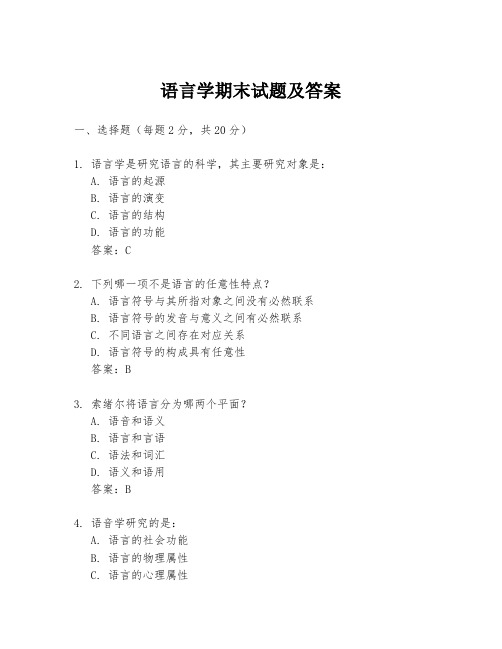
语言学期末试题及答案一、选择题(每题2分,共20分)1. 语言学是研究语言的科学,其主要研究对象是:A. 语言的起源B. 语言的演变C. 语言的结构D. 语言的功能答案:C2. 下列哪一项不是语言的任意性特点?A. 语言符号与其所指对象之间没有必然联系B. 语言符号的发音与意义之间有必然联系C. 不同语言之间存在对应关系D. 语言符号的构成具有任意性答案:B3. 索绪尔将语言分为哪两个平面?A. 语音和语义B. 语言和言语C. 语法和词汇D. 语义和语用答案:B4. 语音学研究的是:A. 语言的社会功能B. 语言的物理属性C. 语言的心理属性D. 语言的语法结构答案:B5. 下列哪一项不属于词汇语义学的研究范畴?A. 同义关系B. 反义关系C. 句法结构D. 词义变化答案:C6. 语言的最小意义单位是:A. 音位B. 词C. 词素D. 语素答案:C7. 语言的组合规则属于:A. 语音学B. 词汇学C. 句法学D. 语用学答案:C8. 语言的聚合规则属于:A. 语音学B. 词汇学C. 句法学D. 语用学答案:B9. 下列哪一项是社会语言学的研究内容?A. 语言的起源B. 语言的演变C. 语言的社会功能D. 语言的语法结构答案:C10. 语言的变异性体现在:A. 语音的变化B. 语法的变化C. 词汇的变化D. 所有选项答案:D二、填空题(每空1分,共10分)1. 语言学的分支学科包括语音学、语法学、__________、语用学等。
答案:词汇学2. 语言的两种基本功能是表达和__________。
答案:交流3. 索绪尔认为语言符号是由__________和所指构成的。
答案:能指4. 语言的音位变体称为__________。
答案:音位变体5. 语言的最小语音单位是__________。
答案:音素6. 语言的最小语法单位是__________。
答案:词7. 语言的最小语义单位是__________。
答案:语义素8. 语言的__________是指语言随时间的演变。
语言学概论期末考试复习题及参考答案

语言学概论(八)期末考试复习题及参考答案一、单选题1.(2分)语言符号的任意性是指A.语言符号可以任意使用和创造B.绝大多数语言符号的能指和所指之间没有必然的理据关系C,可以任意使用语言符号绐事物命名D∙语言符号的能指和所指可以任意改变参考答案:B2.(2分)下列各组辅音中,发音部位相同的•组是A.image1..pngB.image2.pngC.image3.pngD.Image4.png参考答案:B3.(2分)“汽车”和“轿车”是A.上下位词B.同义词C.等义词D.近义词参考答案,A4.(2分)下列几种社会方言中,具有排他性的一项是A.阶级习惯语B.行话C隐语D.学生腔参考答案:C5.(2分)下列关于亲属语言的表述中,不正确的项是A亲属语言是社会完全分化的产物B∙亲属语言之间具有历史同源关系C.语言亲属关系有亲疏远近的分别D.亲属语言间不存在语音对应关系参考答案:D6..(2分)“老郎鼓励我考大学”是A.生谓诃组B.兼语词组C.连动词组D.复句词组参考答案,B7.12分)目前己知的最古老的拼音文字是一A.古埃及文字8.占希腊文字C腓尼基文字D∙中国的甲骨文参考答案:C9.(2分)划分词类的最本质的标准是A.分布标准8.意义标准C.形态标准D逻辑标准参考答案,A9.(2分)外语学习中的后期阶段被称为A.中介语阶段B.目标语阶段C低平期D高原期参考答案I D10.(2分)英语“students"中的"∙s"是.A.虚词语素B∙词根语素C.构形语素D.构词语素参考答案:C11.(2分)认为“思维和语言各自发展,二者没仃关系”的学者不包括A.古希腊哲学家柏拉图B.法国哲学家迪卡尔C.英国哲学家座布斯D.苏联语言学家马尔参考答案:D12.(2分)以卜.不属于语言学的三大发源地的是A.中国B.埃及C.印度D希腊•罗马参考答案,B13.(2分)下列语言学流派中桀中研究语言本体的流派是A.功能语言学B∙社会语言学C认知语言学D.结构语言学春考答案:D14.(2分)下面词组中,结构类型与其他各组不同的•组是A.年轻漂亮/朴素大方B.我们大家/首都北京C.民航大厦/工人农民D.贯彻执行/讨论研究辨考答案:C15.(2分)关于语言获得的原因,卜列学说中偏重于内部条件解择的一项是A.天赋说B.摹仿说C强化说D剌激反应说参考答案;A16.(2分)传统上把汉字的单纯字符称为A偏旁B笔画C记号D.独体字参考答案,D17.(2分)北京话“面”单念时读作但“面包”却读作[mi?mpau),这种语流音变现象是A溺化B.增音C同化D.异化春考答案:C18.(2分)汉语中的词类(词的语法分类)可以首先分出的两个大类是一A.基本词和非基本词B.实诃和虚词C.典型词和兼类词D.体词和谓词参考答案:B19.(2分)目前对于语言和思维的关系,比较一致的观点是A.有什么样的思维,就有什么样的语言B∙有什么样的语言,就有什么样的思维C思维对语言有•定影响,但更重要的是语言决定思维D.语言对思维有一定影响,但更重要的是思维决定语言参考答案,D20.(2分)听觉上最自然、最容易分辨的最小语音单位是A.音素B.国i音C音位D.音节参考答案:D21.(2分)首先提出“能指”和“所指”这对概念的语言学家是A洪堡特B.索绪尔D.萨丕尔分考答案:B22.(2分)判断两种话是不同语言还是同一种语言的不同方言应该主要参考A.相互理解程度B.语言结构的差异程度C.共同的历史文化传统和民族认同感D∙地域临近程度参考答案,C23.(2分)语言符号具有可变性的根本原因在丁语言符号的A.任意性B.强制性C离散性D.系统性参考答案:A24.(2分)下列各项中,谓词和变元之间属于动作与结果关系的是A.写黑板B.打篮球C.织毛衣D.寄包裹参考答案,C25.(2分)从词的构造类型上看,汉语“动人”一词属于A.单纯词B.复合词D.简缩词参考答案:B26.(2分)语法的演变之所以比语汇缓慢,是因为A语法规则比较简单B.语法规则数量较少C.语法规则具有强制性D∙语法规则具有抽象性参考答案IC27.(2分)构形语素属于A.虚词语素B.词根语素C.自由语素D.黏若语素参考答案:D28.(2分)下列各组中,三个复合词构词类型不一致的一组是A.席卷耳鸣地震B.打倒切断推翻C发光散热出气D.天地欢乐爱好弁考答案:A29.(2分)在语言谱系分类的层级体系中,域大的类别是一A.语族B.语支C.语系D∙语群参考答案,C30.(2分)从语音的社公功能角度划分出来的最小语音单位是A.音位B.音素C.音节D.各渡参考答案:B31.(2分)人类语言和动物的交际方式A.完全一致B.有根本区别C有•定的差别D∙基本一样参考答案:B32.(2分)“我知道你很聪明。
语言学期末复习资料

语言学概论练习题(一、二)第一部分语言与语言学一.填空题1.中国、印度、希腊—罗马具有悠久的历史文化传统,是语言学的三大发源地。
2. _文言___是我国古代的书面语,用它写成的文章称为文言文。
3.文字学、音韵学、训诂学是我国传统的语文学。
4.研究语言的结构,主要是研究语音、词汇、语法三个部分。
5.运用语言传递信息的过程,可以分为编码、发送、传递、接收、解码五个阶段。
6.人和动物的区别是人会制造工具,而且人类有语言,这是人和动物相区别的重要标志之一。
7.一种语言中的句子数量是无限的,人类之所以能掌握语言,是因为构成句子的_规则_是十分有限的。
8.语言是人类社会的交际工具,而且也是思维的工具。
9.在一定条件下,身体姿势等伴随动作还可以离开语言独立完成交际任务。
例如汉民族点头表示肯定,摇头表示否定,送别时挥手表示再见,鼓掌表示欢迎,咬牙切齿表示愤怒,手舞足蹈表示兴奋。
10.人的大脑分左右两半球,大脑的左半球控制语言活动,右半球掌管不需要语言的感性左直观思维。
11.汉语的哥哥、弟弟,英语用 siste 表示,汉语的舅父、姨父、姑父、叔叔,英语用uncle 表示。
12.英语可以直接用数词修饰名词,汉语数词修饰名词一般要加上一个量词。
13.儿童最早的智力活动就是学习语言。
14.任何符号,都是由形式和意义两个方面构成的。
15.一个符号,如果没有意义,就失去了存在的必要,如果没有形式,我们就无法感知,符号也就失去了存在的物质基础。
16.语言符号是语音和意义的统一体,声音是语言符号的形式。
17.用什么样的语音形式代表什么样的意义,完全是由使用这种语言的社会成员约定俗成。
18.语言符号具有任意性和线条性特点。
19.语言的底层是一套音位,上层是符号和符号的序列,可以分为若干级,第一级是语素,第二级是词,第三级是句子。
20.语言系统中的所有符号,既可以同别的符号组合,又可以被别的符号替换,符号之间的这两种关系是组合关和聚合关系。
语言学入门考试题及答案

语言学入门考试题及答案一、选择题(每题2分,共20分)1. 语言学的主要研究对象是什么?A. 语言B. 文学C. 历史D. 数学答案:A2. 以下哪个选项不属于语言学的分支?A. 语音学B. 语法学C. 心理学D. 语义学答案:C3. 语言学研究的是哪类现象?A. 物理现象B. 自然现象C. 社会现象D. 文化现象答案:C4. 语言的最小意义单位是什么?A. 音素B. 词C. 句子D. 语篇答案:A5. 以下哪个术语不属于语言变异?A. 方言B. 社会方言C. 语言接触D. 语言死亡答案:D6. 语言的哪一层级负责表达意义?A. 语音层B. 语法层C. 语义层D. 语用层答案:C7. 以下哪个选项是语言的交际功能?A. 表达情感B. 描述事物C. 命令他人D. 所有选项答案:D8. 以下哪个选项是语言的内部结构?A. 音位B. 词汇C. 语音D. 语法答案:D9. 以下哪个选项是语言的外部功能?A. 信息传递B. 情感表达C. 命令控制D. 所有选项答案:D10. 语言的哪一层级负责表达关系?A. 语音层B. 语法层C. 语义层D. 语用层答案:B二、填空题(每题2分,共20分)1. 语言学研究的最小意义单位是________。
答案:音素2. 语言学研究的最小语音单位是________。
答案:音位3. 语言学研究的最小语法单位是________。
答案:词4. 语言学研究的最小语义单位是________。
答案:词义5. 语言学研究的最小语用单位是________。
答案:句子6. 语言学研究的最小社会单位是________。
答案:方言7. 语言学研究的最小文化单位是________。
答案:语言8. 语言学研究的最小交际单位是________。
答案:话语9. 语言学研究的最小心理单位是________。
答案:概念10. 语言学研究的最小认知单位是________。
答案:思维三、简答题(每题10分,共30分)1. 简述语言学的主要研究内容。
语言学概论期末突击复习资料.doc
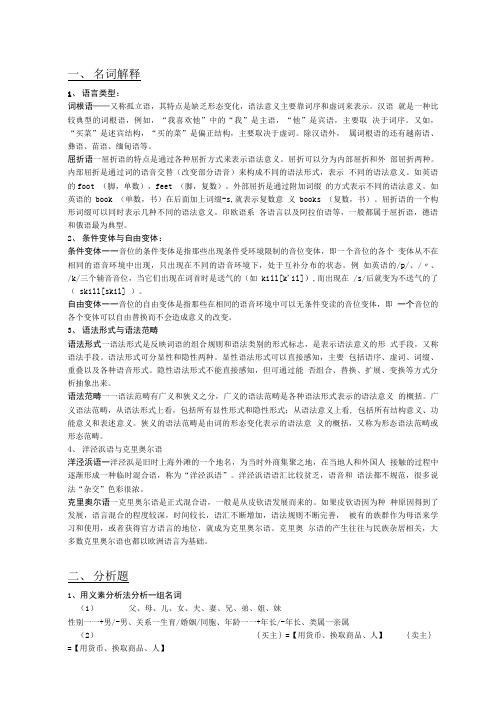
一、名词解释1、语言类型:词根语——又称孤立语,其特点是缺乏形态变化,语法意义主要靠词序和虚词来表示。
汉语就是一种比较典型的词根语,例如,“我喜欢他”中的“我”是主语,“他”是宾语,主要取决于词序。
又如,“买菜”是述宾结构,“买的菜”是偏正结构,主要取决于虚词。
除汉语外,属词根语的还有越南语、彝语、苗语、缅甸语等。
屈折语一屈折语的特点是通过各种屈折方式来表示语法意义。
屈折可以分为内部屈折和外部屈折两种。
内部屈折是通过词的语音交替(改变部分语音)来构成不同的语法形式,表示不同的语法意义。
如英语的foot (脚,单数),feet (脚,复数)。
外部屈折是通过附加词缀的方式表示不同的语法意义。
如英语的book (单数,书)在后面加上词缀-s,就表示复数意义books (复数,书)。
屈折语的一个构形词缀可以同时表示几种不同的语法意义。
印欧语系各语言以及阿拉伯语等,一般都属于屈折语,德语和俄语最为典型。
2、条件变体与自由变体:条件变体一一音位的条件变体是指那些出现条件受环境限制的音位变体,即一个音位的各个变体从不在相同的语音环境中出现,只出现在不同的语音环境下,处于互补分布的状态。
例如英语的/p/、/〃、/k/三个辅音音位,当它们出现在词首时是送气的(如kill[k'il]),而出现在/s/后就变为不送气的了(skill[skil] )。
自由变体一一音位的自由变体是指那些在相同的语音环境中可以无条件变读的音位变体,即一个音位的各个变体可以自由替换而不会造成意义的改变。
3、语法形式与语法范畴语法形式一语法形式是反映词语的组合规则和语法类别的形式标志,是表示语法意义的形式手段,又称语法手段。
语法形式可分显性和隐性两种。
显性语法形式可以直接感知,主要包括语序、虚词、词缀、重叠以及各种语音形式。
隐性语法形式不能直接感知,但可通过能否组合、替换、扩展、变换等方式分析抽象出来。
语法范畴一一语法范畴有广义和狭义之分,广义的语法范畴是各种语法形式表示的语法意义的概括。
语言学概论期末考试试题

语言学概论期末考试试题一、名词解释(每题 5 分,共 20 分)1、语言语言是人类最重要的交际工具和思维工具,是一种音义结合的符号系统,由语音、词汇和语法构成。
它具有任意性、线条性、系统性等特点,能够传递信息、表达思想、交流感情。
2、语素语素是语言中最小的音义结合体,是构词的基本单位。
根据能否单独成词,语素可分为成词语素和不成词语素。
3、语法范畴语法范畴是由词的变化形式所表示的语法意义的概括。
常见的语法范畴包括性、数、格、时、体、态、人称等。
4、社会方言社会方言是社会内部不同年龄、性别、职业、阶级、阶层的人们在语言使用上表现出来的一些变异,是言语社团的一种标志。
二、填空题(每题 2 分,共 20 分)1、现代语言学之父是________。
2、语言的功能包括________、________、________等。
3、世界上使用人数最多的语言是________,使用范围最广的语言是________。
4、音素分为________和________两大类。
5、基本词汇具有________、________、________等特点。
6、句子按语气可分为________、________、________、________四类。
7、文字的发展经历了________、________、________三个阶段。
8、语言演变的特点有________、________、________。
9、借词也叫________,是指一种语言从外族语言中借入的词。
10、汉语属于________语系,英语属于________语系。
三、选择题(每题 2 分,共 20 分)1、下列语言中属于粘着语的是()A 汉语B 英语C 日语D 俄语2、下列音素中属于元音的是()A pB mC uD f3、“黑板”这个词属于()A 单纯词B 合成词C 派生词D 复合词4、“他跑得很快”中“得”的作用是()A 表示可能B 表示程度C 表示结果D 表示趋向5、下列句子中属于主谓谓语句的是()A 他身体很好。
语言学概论期末考试试卷及答案
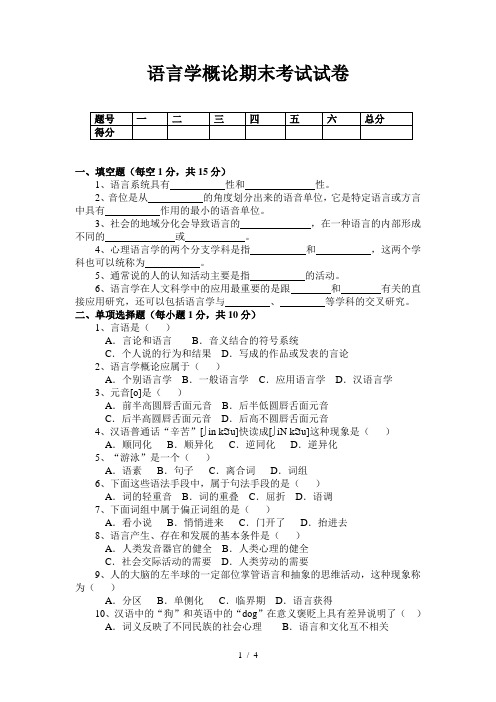
语言学概论期末考试试卷一、填空题(每空1分,共15分)1、语言系统具有性和性。
2、音位是从的角度划分出来的语音单位,它是特定语言或方言中具有作用的最小的语音单位。
3、社会的地域分化会导致语言的,在一种语言的内部形成不同的或。
4、心理语言学的两个分支学科是指和,这两个学科也可以统称为。
5、通常说的人的认知活动主要是指的活动。
6、语言学在人文科学中的应用最重要的是跟和有关的直接应用研究,还可以包括语言学与、等学科的交叉研究。
二、单项选择题(每小题1分,共10分)1、言语是()A.言论和语言B.音义结合的符号系统C.个人说的行为和结果D.写成的作品或发表的言论2、语言学概论应属于()A.个别语言学B.一般语言学C.应用语言学D.汉语言学3、元音[o]是()A.前半高圆唇舌面元音B.后半低圆唇舌面元音C.后半高圆唇舌面元音D.后高不圆唇舌面元音4、汉语普通话“辛苦”[⎭in kℑu]快读成[⎭i N kℑu]这种现象是()A.顺同化B.顺异化C.逆同化D.逆异化5、“游泳”是一个()A.语素B.句子C.离合词D.词组6、下面这些语法手段中,属于句法手段的是()A.词的轻重音B.词的重叠C.屈折D.语调7、下面词组中属于偏正词组的是()A.看小说B.悄悄进来C.门开了D.抬进去8、语言产生、存在和发展的基本条件是()A.人类发音器官的健全B.人类心理的健全C.社会交际活动的需要D.人类劳动的需要9、人的大脑的左半球的一定部位掌管语言和抽象的思维活动,这种现象称为()A.分区B.单侧化C.临界期D.语言获得10、汉语中的“狗”和英语中的“dog”在意义褒贬上具有差异说明了()A.词义反映了不同民族的社会心理B.语言和文化互不相关C.中英文化没有相通之处D.不同民族思维不同三、名词解释(每小题4分,共16分)1、语义场2、地域方言3、语言信息处理4、语音的生理属性四、简答题(每小题7分,共21分)1、简要叙述语言的客观存在形式和人的主观认识的关系。
语言学概论复习(全)
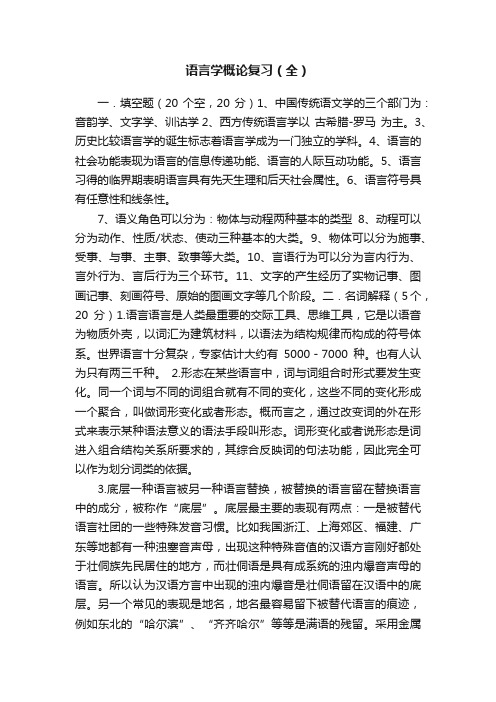
语言学概论复习(全)一.填空题(20个空,20分)1、中国传统语文学的三个部门为:音韵学、文字学、训诂学2、西方传统语言学以古希腊-罗马为主。
3、历史比较语言学的诞生标志着语言学成为一门独立的学科。
4、语言的社会功能表现为语言的信息传递功能、语言的人际互动功能。
5、语言习得的临界期表明语言具有先天生理和后天社会属性。
6、语言符号具有任意性和线条性。
7、语义角色可以分为:物体与动程两种基本的类型8、动程可以分为动作、性质/状态、使动三种基本的大类。
9、物体可以分为施事、受事、与事、主事、致事等大类。
10、言语行为可以分为言内行为、言外行为、言后行为三个环节。
11、文字的产生经历了实物记事、图画记事、刻画符号、原始的图画文字等几个阶段。
二.名词解释(5个,20分)1.语言语言是人类最重要的交际工具、思维工具,它是以语音为物质外壳,以词汇为建筑材料,以语法为结构规律而构成的符号体系。
世界语言十分复杂,专家估计大约有5000-7000种。
也有人认为只有两三千种。
2.形态在某些语言中,词与词组合时形式要发生变化。
同一个词与不同的词组合就有不同的变化,这些不同的变化形成一个聚合,叫做词形变化或者形态。
概而言之,通过改变词的外在形式来表示某种语法意义的语法手段叫形态。
词形变化或者说形态是词进入组合结构关系所要求的,其综合反映词的句法功能,因此完全可以作为划分词类的依据。
3.底层一种语言被另一种语言替换,被替换的语言留在替换语言中的成分,被称作“底层”。
底层最主要的表现有两点:一是被替代语言社团的一些特殊发音习惯。
比如我国浙江、上海郊区、福建、广东等地都有一种浊塞音声母,出现这种特殊音值的汉语方言刚好都处于壮侗族先民居住的地方,而壮侗语是具有成系统的浊内爆音声母的语言。
所以认为汉语方言中出现的浊内爆音是壮侗语留在汉语中的底层。
另一个常见的表现是地名,地名最容易留下被替代语言的痕迹,例如东北的“哈尔滨”、“齐齐哈尔”等等是满语的残留。
语言学概论期末复习重点练习题

语言学概论练习题(一)导言一、填空1.语言学的三大发源地是。
2.语言学是世纪成为独立的学科的,其标志是。
3.现代语言学的标志性著作是瑞士语言学家的。
4.中国“小学”的主要研究内容是。
5.关于语言的一般规律的理论研究被称为语言学。
6.语言学是和联系的桥梁。
二、判断正误1.语文学主要是研究古代的口语和书面语。
2.语言有自身结构的独立性,与系统之外的社会环境没有关系。
3.理论语言学是研究语言一般规律的,不受具体语言研究影响。
4.研究语言每个子系统在不同时期所发生的变化及其变化中不同子系统的关联就是共时语言学。
5.语言学是一门既古老又年轻充满活力的科学。
6.语言形式和内容的关系是语言研究的根本问题。
三、思考题1.为什么说语言学是自然科学和人文科学的桥梁?第一章一、填空1.语言的功能包括功能和功能。
2.语言的社会功能包括功能和功能。
3.在各种信息传递形式中,是第一性的、最基本的手段。
4.人的大脑分为左右两个半球,语言功能及计数、推理能力等由半球掌管,音乐感知、立体图形识别等能力由半球制约。
5.儿童语言习得一般经过阶段和阶段,这是儿童学话的关键两步。
二、判断正误1.文字是建立在语言基础上的再编码形式。
2.书刊上的话语不具有人际互动功能。
3.抽象思维要以语言为形式依托。
4.聋哑人不会说话,所以不具备抽象思维的能力。
5.不同语言结构的差异体现出思维方式的不同。
三、思考题1.为什么说语言是一种特殊的社会现象?2.为什么说语言是人类最重要的信息传递手段?第二章一、填空1.说出的话语句子是无限的,但无限多的句子都是由有限的和组装起来的。
2.符号包括和两个方面,二者不可分离。
3.语言符号的意义是对它指代的一类的概括。
4.语言符号的和,是语言符号的基本性质。
5.语言符号系统是一种,这种装置靠和来运转。
6.语言系统二层性的一大特点是层的最小单位一定少于层的最小单位。
7. 和是语言系统中的两种根本关系。
8.动物无法掌握人类的语言,从生理基础看是不具有和。
- 1、下载文档前请自行甄别文档内容的完整性,平台不提供额外的编辑、内容补充、找答案等附加服务。
- 2、"仅部分预览"的文档,不可在线预览部分如存在完整性等问题,可反馈申请退款(可完整预览的文档不适用该条件!)。
- 3、如文档侵犯您的权益,请联系客服反馈,我们会尽快为您处理(人工客服工作时间:9:00-18:30)。
《语言学入门》期末复习题(2013秋)I. 选择题1.()Of all the speech organs, the ___ is/are the most flexible.A. mouthB. lipsC. tongueD. vocal cords2.()The theme of Unit 3 is the _______ nature of language inwhich the author describes one of the most fundamentalaspects of linguistics.A. organicB. symbolicC. physicalD. phonetic3.()According to Krashen, ___ refers to the gradual andsubconcious development of ability in the first languageby using it naturally in daily communicative situations.A. learningB. competenceC. performanceD. acquisition4.()Using “transfer of population”to refer to the fact thatmillions of peasants are robbed of their farms is anexample of ________.A. the symbolic nature of languageB. language being affected by politicsC. language affecting status identityD. the metaphoric extension of language5.()The organized network of knowledge that helps us tounderstand new knowledge is called __________.A. paradigmB. hedgeC. aphasiaD. schema6.()The location of language skills in the brain is studied byspecialists in the field of ______.A. psycholinguisticsB. neurolinguisticsC. speech therapyD. cognitive linguistics7. ()Which of the following theories is NOT discussed in Unit 9?________A. the critical period for language hypothesisB. Linguistic ImperialismC. the theory of schemaD. long term memory and short term memory8. ()This course requires a learner to deal with three differenttasks. They are ________.A. awareness tasks, understanding tasks and analytic tasksB. awareness tasks, application tasks and analytic tasksC. understanding tasks, application tasks and analytic tasksD. awareness tasks, understanding tasks and application9. ()In the process of abstracting, sometimes we need to classifyan animal into a certain class meanwhile ignoring somedifferences. We call this step as ________.A. bracketingB. achieving abstractionC. capturing immediate experienceD. further abstracting10. ()Speech Act theory was firstly put forward by ________.A. J. L. AustinB. LeechC. Noam ChomskyD. Clark & Clark()11. As modern linguistics aims to describe and analyze the language people actually use, and not to lay down rules for"correct" linguistic behavior,it is said to be _____.A. prescriptiveB. sociolinguisticC. descriptiveD. psycholinguistic()12. Of all the speech organs, the _____ is/are the most flexible.A. mouthB. lipsC. tongueD. vocal cords()13. The morpheme "vision" in the common word "television"is a(n) _____.A. bound morphemeB. bound formC. inflectional morphemeD. free morpheme()14. A _____ in the embedded clause refers to the introductory word thatintroduces the embedded clause.A. coordinatorB. particleC. prepositionD. subordinator主从连词()15、"Can I borrow your bike?" _____ "You have a bike."A. is synonymous withB. is inconsistent withC. entailsD. presupposes()16. The course Language and Linguistics is about_____.A. one's native languageB. language in generalC. any particular languageD. the main languages()17. The physical process of vocalization is studied by people who work in the field of ______.A. phoneticsB. phonologyC. rhetoricD. speech synthesis()18. In producing the sound /k/ the ______ part of the tongue is used.A. tipB. frontC. bladeD. back()19. The feature that distinguishes human language from animal language is the_____ of human language.A. innatenessB. vocalizationC. symbolic aspectD. functionalism()20. A functional analysis of language studies _____.A. what sort of things language helps us to doB. how language helps to define national identitiesC. how we organize our experience through languageD. how we manage interpersonal relationships through languageII.判断题1. ()Historical linguistics equals to the study of synchronic study.2. ()The smallest meaningful unit of language is allomorph.3. ()Talk is the fourth function of language discussed in thistextbook and has been a topic long ignored by linguisticexperts.4. ()Status and regional identity can be linked to dialect.5. ()If you’re insincere in expressing congratulations tosomebody, your illocutionary act is flawed.6.()Cognitive capacity is relevant to second language learning.7.()Abstraction is an extrinsic feature of language.8. ()Aphasiology studies the handicap of languagecomprehension and /or production.9.()Naming is an example of a function performed by language.10.()In interpersonal contact in China, considerateness is other-oriented.11. ()Linguistically, "language" refers to spoken languagebecause language is primarily spoken.12. ()Most languages use the air flowing inwards.13. ()In all languages words enter into syntagmatic relations.14. ()"Tense" is a particular way of recording time. People in theworld all do things connected with time; therefore allthe languages have tense.15. ()The speech act theory holds that when people saysomething, they perform the locutionary, illocutionaryand perlocutionary acts one by one.16. ()In contrast with a collective culture, the interests of thegroup or community are considered of greaterimportance in an individualist culture.17. ()Address terms are equally associated with politeness inboth Chinese and English.18. ()Gestures are an example of given-off information in face-to-face talk.19. ()For overseas Chinese, learning spoken Chinese is primaryand more important than written Chinese.20. ()Reasoning and language are both controlled by the lefthemisphere of the brain.III. 名词解释1、duality2、diachronic linguistics3、broad transcription4、morphological rules5、phrase structure ruleIV. 选词填空(从下面方框中选出可是的词填在空格里)1. A sentence is a structurally independent unit that usuallycomprises a numberof ________ to form a complete statement, ________ or command.2. In sociolinguistic studies, speakers are treated as members of________________ .3. Utterance is based on ________ ________; it is the realization of the abstractmeaning of a sentence in a real situation of communication, or simply in a context.4. To many people, a linguist is the same as a ________, one who canspeakseveral languages fluently.5. Consonant sounds can be either ________or ________, while allvowel soundsare _________.V. 回答下列问题1. What are the different dimensions of relations between people in thesociety? What is the one dimension important to Chinese but absent in some other cultures? Choose one dimension to give an example.2. Briefly discuss the individual factors which affect the acquisition of a second language.。
